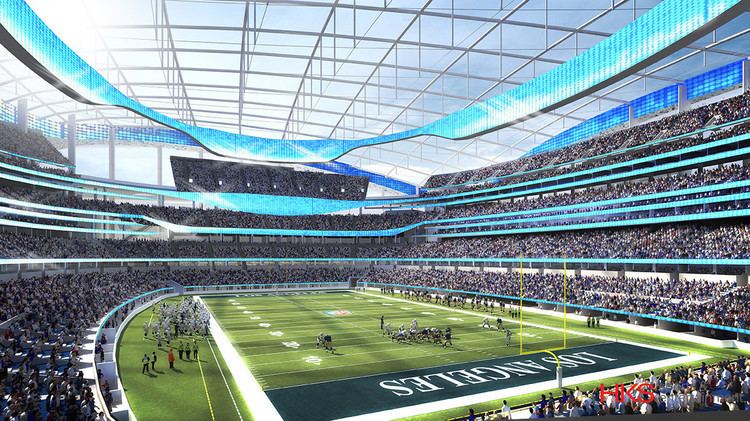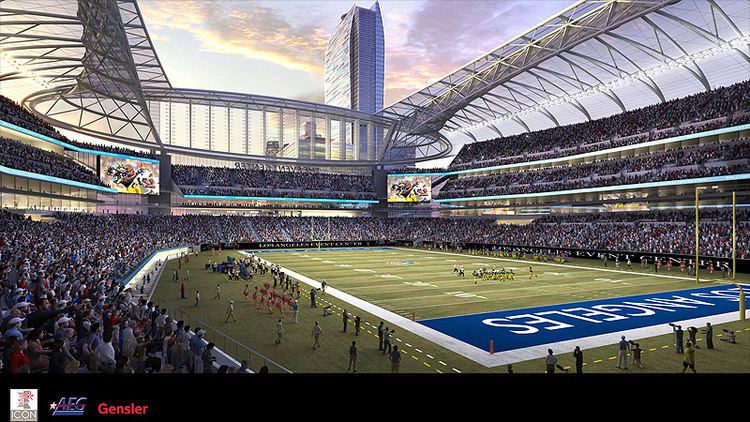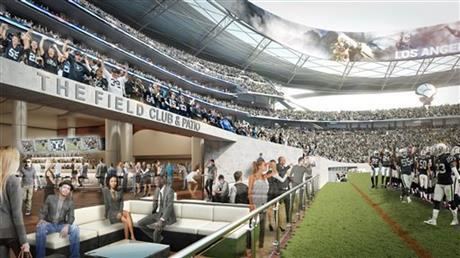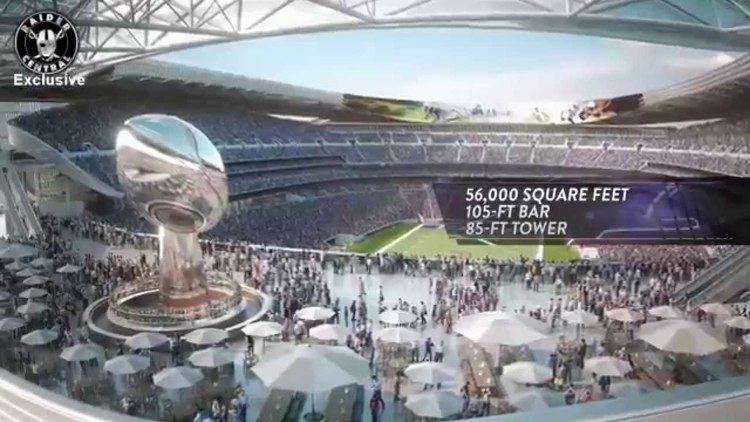Capacity 75,000 Architecture firm Aedas | Owner Edward P. Roski Architect Dan Meis | |
 | ||
Location Industry, California
Grand Crossing, California Construction cost $800 million (estimated) Similar Los Angeles Stadium, Farmers Field, Carson Stadium, San Diego Chargers stadium p, Los Angeles Memorial | ||
Los Angeles Stadium was a proposed 75,000-seat football stadium, the centerpiece of a 600-acre entertainment district in Industry, California. Edward P. Roski, a part-owner of the Los Angeles Lakers of the NBA and Los Angeles Kings of the NHL, announced plans for the stadium on the northern side of the interchange of state routes 57 and 60, 22 miles (35 km) east of Downtown Los Angeles with the purpose of attracting an NFL team to the Los Angeles region. The Greater Los Angeles Area, the second-largest metropolitan area in the United States, was the nation's largest media market without an NFL team from 1995 to 2015. Upon construction, the district would be named Grand Crossing, California.
Contents
The proposal, although it was never publicly withdrawn, was effectively rendered obsolete after the league approved the St. Louis Rams' relocation to Los Angeles in 2016; the Rams' proposal involves building their own City of Champions Stadium in Inglewood. The Industry proposal, which received a full approval from all regulatory authorities but never found a willing team to move into the proposed stadium, sat dormant from 2011 until the Inglewood proposal was approved.

History

Roski, who helped build Staples Center, stated that the new 75,000-seat stadium would be privately financed and would be the centerpiece of a new 600-acre entertainment and retail complex in Industry which would have included 25,000 ample on-site parking spaces. The proposed stadium and mixed-use development was designed by Dan Meis, FAIA, and Aedas Sport out of Los Angeles. The Los Angeles County site would have put it in reach of 12 million people in a 25-mile (40 km) radius, including in Orange, Riverside, and San Bernardino Counties and the San Fernando Valley. Roski and his spokesman have asserted that a football stadium in the city could mean as much as $400 million in yearly revenue to businesses and bring more than 18,000 jobs to the area. Project supporters asserted that aspects of the stadium design, such as the use of hilly terrain to vastly reduce the cost of construction and the multi-use capabilities of the planned surrounding development, as well as Roski's success in gaining support from local elected officials in the City of Industry, where the proposed stadium site is located, gave the plan a strong possibility of success. Project critics asserted that it required more public funding than had been stated, and questioned the costs and benefits of the project.

Roski said he would not break ground on the stadium until he has a commitment from an NFL team to move to Los Angeles. In exchange for footing the bill to construct the stadium, Roski wanted at least a 30% ownership stake in any team that moved to Los Angeles to play there.

Given that the National Football League was not planning on expanding the developers of the new stadium stated on their website that their tenant would be an existing team "that needs to move because they cannot build a new stadium or financially they are not successful in their current market. We can not disclose which teams we are talking with." The three teams which used to play in Los Angeles but moved elsewhere (the San Diego Chargers, St. Louis Rams and Oakland Raiders (The Chargers and Rams eventually moved back to Los Angeles)) were suspected possible tenants. The Jacksonville Jaguars and the Minnesota Vikings had also been identified by Roski and others as possible prime tenants of the new stadium. The Minnesota Vikings were officially taken out of the race after a financial package providing for construction of a new stadium in Minneapolis was approved by both the Minnesota State Legislature and the Minneapolis City Council. The Jaguars also became no longer an option for Roski. Wayne Weaver, during his press conference announcement of selling the Jaguars to Shahid Khan during mid-season in 2011, explained that Roski did call him in an attempt to buy the team, but was instantly turned down, saying "It was a waste of my time and his". Khan said that he wants to put the city of Jacksonville on the map and had no plans to move the team. The Buffalo Bills were also considered a potential relocation candidate, but the city of Buffalo was able to force the team to sign an ironclad lease in 2012 prohibiting them from relocating and, through political and community pressure, dissuaded all Los Angeles-based prospective buyers from bidding on the team when it came up for sale in 2014 eventually selling to Terry and Kim Pegula.

On February 28, 2009 the City of Industry city council approved the environmental impact report 5-0. The neighboring cities of Diamond Bar and Walnut both expressed concerns about the noise, traffic, and environmental impacts of the proposed stadium. Walnut and a Walnut-based citizens group comprising eight homeowners filed lawsuits to block the project, but were unsuccessful.
On April 8, 2009 the city of Diamond Bar unanimously approved a legal settlement that granted it more than $21 million in exchange for dropping objections to the stadium. Diamond Bar City Council members approved the agreement with the City of Industry. The settlement included $20 million to deal with increased traffic from the stadium and $1 million for a middle school athletic field. Diamond Bar also would have received at least $700,000 per year from Industry for community facilities as long as the stadium remained in operation.
On September 23, 2009 the city of Walnut reached a settlement with the City of Industry and the stadium developer. A group of Walnut citizens refused to settle its lawsuit. The group insisted that the stadium have a domed roof and special freeway exits. On October 14, 2009 the state Senate approved a bill to exempt the proposed stadium from state environmental law, effectively killing the lawsuit filed by the citizen group. Governor Arnold Schwarzenegger signed the bill shortly thereafter. This move cleared the last regulatory hurdle for the project: the only remaining barrier (aside from the financing) was the "small" (where others have failed previously) detail of finding an NFL team to fill the stadium.
Jon Semcken III, a representative of Majestic Realty Group of Los Angeles, claimed in December 2009 that the company had a 50% chance of luring at least one existing NFL team to Los Angeles in time for the 2010 season, and that they were certain to have one by 2011. However, no teams moved to L.A. in either of those years. A tenant would have had to find a temporary home for at least one season (like the Rams and Chargers did when they moved back to Los Angeles) while the stadium was built.
Rival sites
Several other sites were mentioned as possible locations for a new stadium. Roski's former business partner AEG led the proposal to build Farmers Field near the Staples Center in Downtown Los Angeles, although the project was shut down in March 2015. Then Los Angeles Dodgers owner Frank McCourt had expressed interest in building a new football stadium next to Dodger Stadium (which is also near downtown Los Angeles). Angel Stadium of Anaheim was reconfigured as a baseball-only park in the mid-1990s, but there have been proposals to build a new football stadium next to it. The Oakland Raiders and San Diego Chargers had plans to build a new stadium in Carson, California while Inglewood's city council approved a plan to build a stadium for the St. Louis Rams.
It was the Inglewood stadium proposal that the league ultimately accepted in a January 2016 meeting. The stadium when completed will be the home of the Los Angeles Rams and the Los Angeles Chargers. The acceptance of the Inglewood project with teams signed to move in killed the other stadium projects including Roski's.
